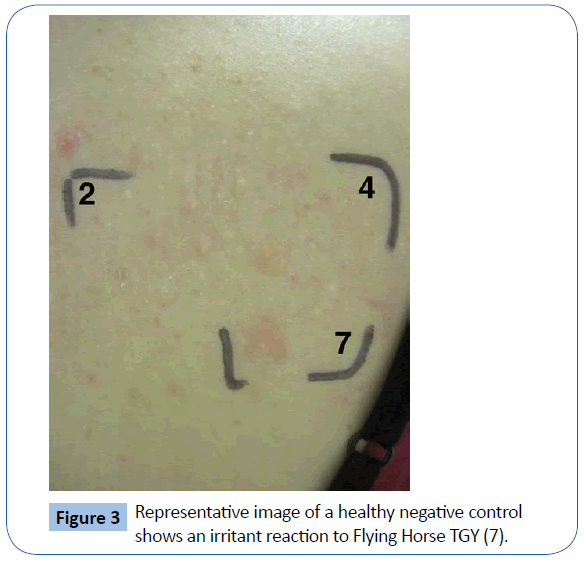George I. Varghese, Jonathan H. Zippin*
Department of Dermatology, Weill Cornell Medical Center, New York, USA
Corresponding Author:
Jonathan H. Zippin
Department of Dermatology, 1305 York Ave, 9th Floor, New York, NY 10021, USA
Tel: 2127464250
E-mail: jhzippin@med.cornell.edu
Background
Brewed tea is a popular beverage consumed worldwide with many beneficial health effects. Rarely, adverse effects have been reported. We describe a case of chronic hand dermatitis resulting from an allergy to black tea.
Case Report
A 59-year-old man presented to our dermatology clinic for a persistent pruritic rash on his hands despite using topical steroids. Examination revealed erythematous scaly patches on the dorsal and palmar aspect of the hands extending to the digits (Figure 1). A skin biopsy showed psoriasiform spongiotic dermatitis. A diagnosis of chronic hand eczema was given and he was subsequently referred for patch testing. History revealed a hobby of drinking exotic teas and blogging his experience. The teas were shipped from China as compressed bricks, which he manually broke apart using his hands and an awl.

Figure 1: Patient presents with scaly erythematous patches on the palm and digits.
Patch testing was performed using the North American Contact Dermatitis Group Series and additional plant derived allergens. We applied ten of the patient’s specialty teas to his back. The leaves were moistened with normal saline and applied to the back using Finn Chambers® mounted on Scanpor® tape. Patient had ++ reactions at D2 and D4 to cinnamal, fragrance mix, and myroxylon pereirae and a + reaction at D4 to specialty teas LKY (raw Pu-ehr), Dio yutai shu (ripe Pu-ehr) and Flying Horse TGY (Oolong). The specialty teas were retested to confirm positive reactions (Figure 2). To rule out an irritant dermatitis from exposure to the teas, we exposed six normal controls to each tea. Normal controls with no history of allergic or irritant contact dermatitis were recruited from the dermatology department. Control patients were exposed with dry and saline soaked tea samples at the same time that our patient was re-exposed to the teas (Figure 2). A + reaction to TGY was noted in three out of six control patients on D4 only and no reaction was noted to LKY and Dio yutai shu on any test days (Figure 3).

Figure 2: Patch testing in our patient revealed three out of ten positive patches from his specialty teas; LKY (2), Dio yutai shu (4), and Flying Horse TGY (7).

Figure 3: Representative image of a healthy negative control shows an irritant reaction to Flying Horse TGY (7).
The patient was instructed to use nitrile gloves when handling the teas and was treated with topical steroids with successful resolution. The use of gloves has prevented any recurrence.
Discussion
Contact dermatitis to teas is rarely reported. There are a handful of case reports of contact dermatitis [1] to chamomile teas with the allergen identified as sesquiterpene lactone. Pigmented cheilitis due to green tea was described as a case report due to possible increased nickel content [2]. To our knowledge, this is the first case report of contact dermatitis to black tea. Our patient had a positive reaction to Pu-ehr tea (LKY and Dio yutai shu) that was suspicious for an allergic-based etiology. Pu-ehr tea is a dark tea that is dried and undergoes post microbial fermentation and oxidation over 6-12 months and then compressed into a brick. Variations of Pu-ehr tea include raw (slow fermentation) and ripe (accelerated fermentation) tea. Once fermented, natural fragrances are added to give variety to the final product. The fragrances, cinnamal, fragrance mix, and myroxylon pereirae, all tested positive in our patient and certain fragrance allergens, such as cinnamal, can be found in small quantities in teas and possibly enhanced during the oxidation of Pu-ehr teas. Thus, one or more fragrance allergens might be the causative agent(s) in our patient. Our patient also reacted to Oolong tea; however, testing of normal control patients helped establish Oolong tea as a likely irritant. Oolong tea goes through a similar fermentation, but is only partially oxidized. The oxidation process creates secondary polyphenols, which may represent potential irritants, however, the actual chemical composition of black tea is not known [3]. While we suspect that the involvement of the dorsal and ventral hands is likely from the mechanical separation of the tea, exposing tea powder to both sides of the hands, it is also possible that he experienced hand dermatitis secondary to consumption of the tea. This case highlights the importance of using normal controls in patch testing to help differentiate true allergic contact dermatitis from irritant reactions.
7719
References
- Pereira F, Santos R, Pereira A (1997) Contact dermatitis from chamomile tea. Contact Dermatitis 36: 307.
- Lee JI, Cho BK, Ock SM, Park HJ (2010) Pigmented contact cheilitis: from green tea? Contact Dermatitis 62: 60-61.
- Tanaka T, Matsuo Y, Kouno I (2009) Chemistry of secondary polyphenols produced during processing of tea and selected foods. Int J Mol Sci 11: 14-40.









